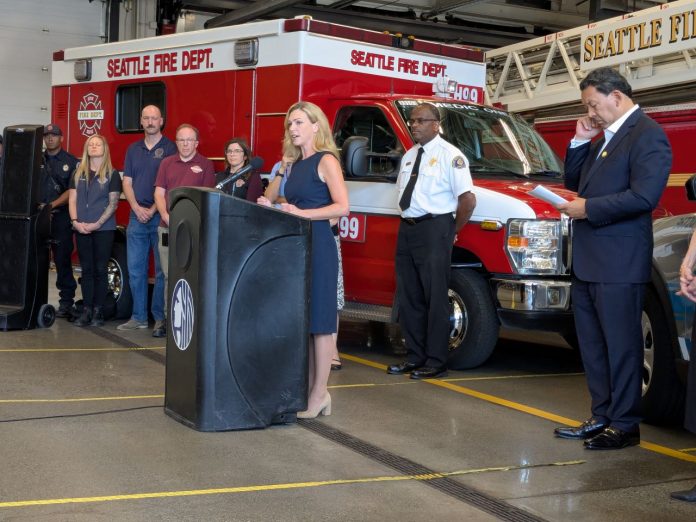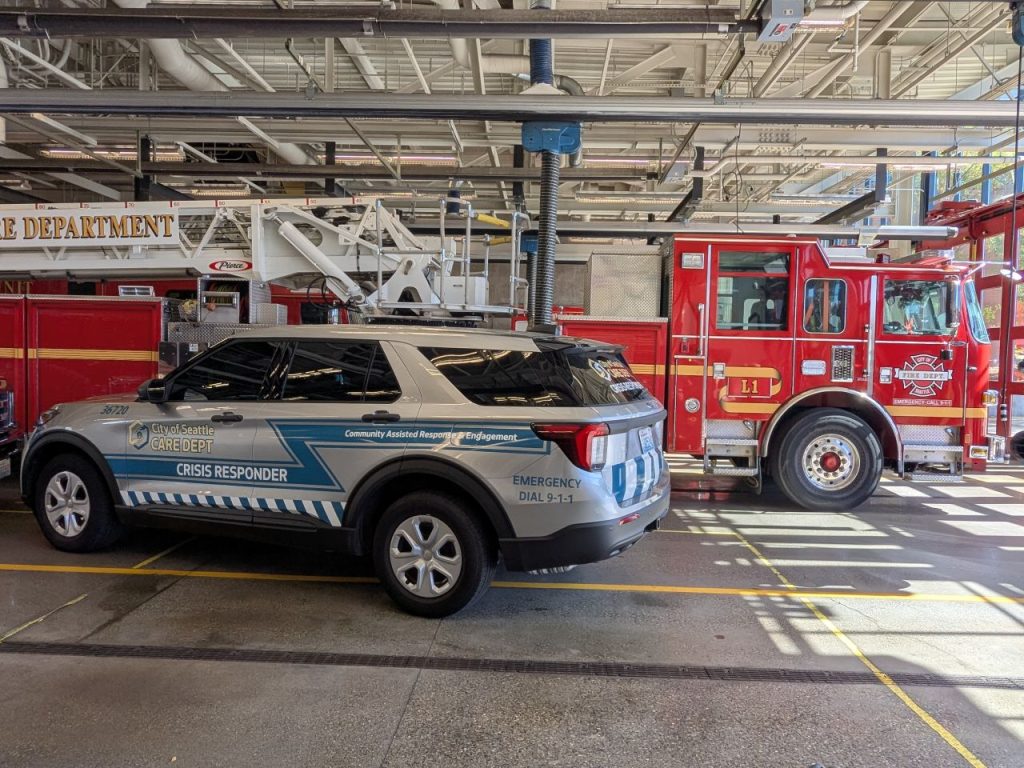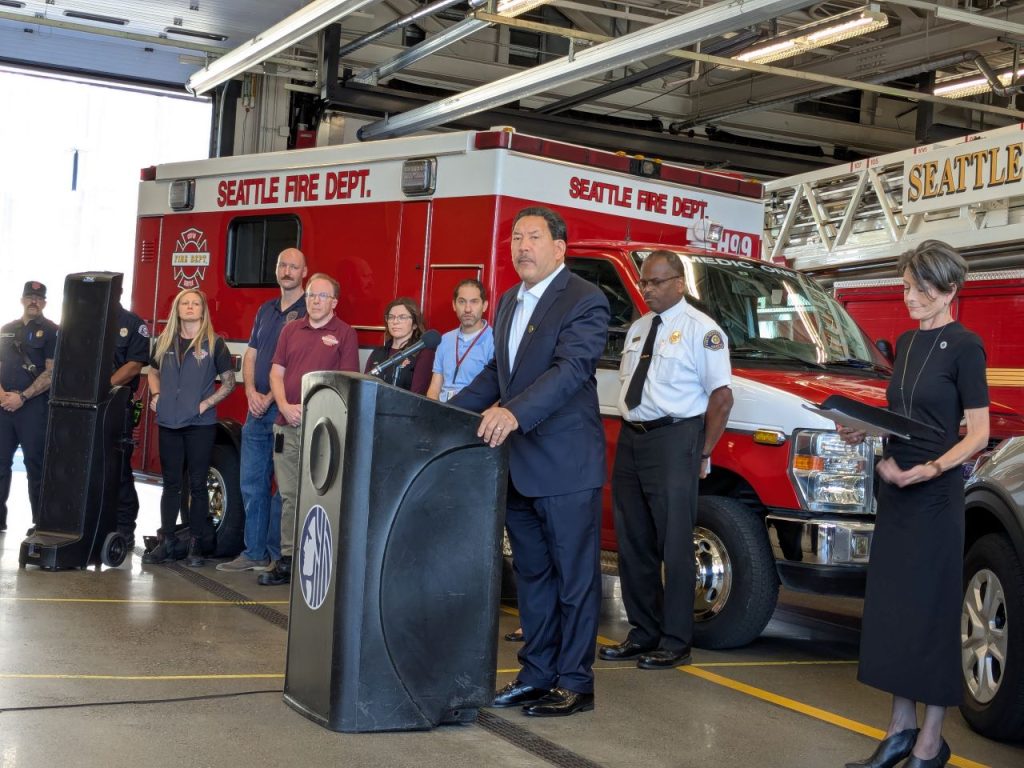
In the 2026 budget, Mayor Bruce Harrell has proposed expanding the Community Assisted Response and Engagement (CARE) Department, which handles the City’s 911 dispatch and the bulk of its alternative response. Harrell has introduced a 0.1% public safety sales tax, greenlit as an option by the state legislature earlier this year, to fund the program.
The sales tax bump would provide funding to double the number of CARE responders currently engaged in crisis response, allowing the program to grow from 24 to 48 responders. CARE would be able to extend its coverage hours to 20 hours a day, seven days a week. Right now, CARE responders are available from 12pm to 10pm.
The increased investment would include more 911 dispatchers and other staff. The public safety sales tax would also provide some ongoing funding for the CARE department, freeing up money in the General Fund (the City’s most flexible pot of money) that would otherwise go to this purpose.
The idea of establishing a robust alternative response system has been enthusiastically discussed in Seattle since 2020 in the wake of George Floyd’s murder at the hands of a Minneapolis police officer.
While alternative response options have gained popularity across the nation, Seattle has fallen behind many comparable cities, such as Albuquerque, New Mexico and Durham, North Carolina. As of September, Albuquerque’s alternative response had answered more than 120,000 calls for service As of July, Durham had responded to over 32,000 calls. By contrast, Seattle’s CARE team had a late start and has responded to fewer than 7,000 calls thus far.
CARE responders expanded to citywide service earlier this year, funded by a federal grant. CARE teams are divided between three zones that roughly correspond to police precincts: one in North Seattle, one in central Seattle, and one in South and West Seattle.
Labor negotiation issues
Amy Barden, the chief of the CARE department, has a vision in which she could dispatch a variety of teams to respond to the proper 911 calls. Right now Barden can dispatch both fire and police responses. CARE responders are required, per the City’s contract with the Seattle Police Officers Guild (SPOG), to be dual dispatch, meaning they are sent with officers from the Seattle Police Department (SPD). While officers are allowed to give CARE teams permission to respond without them, this doesn’t always happen in practice.
Barden told the city council that when CARE teams are dispatched to “priority 3” person down and welfare check calls (the two call types allowed by the SPOG contract), they have to wait an average of 173 minutes for police officers to show up.

Barden said an analysis of 911 calls performed last year showed seven call types, representing more than 47,000 calls last year, almost never result in any kind of law enforcement action. However, the CARE teams are only allowed to respond to two of these seven call types.
“We wasted at minimum 100 police hours a day dispatching police to those calls that could have been better handled by another unit,” Barden said. “And if we want a safe city, this simply has to change.”
Barden told The Urbanist that she was originally told she’d be able to solo dispatch the CARE teams by the end of 2024. The fact that the City still hasn’t negotiated an updated Memorandum of Understanding (MOU) with SPOG to allow for solo dispatch and response to an increased number of call types has been a disappointment to advocates for alternative response.
“The optimist in me believes we’re going to get the MOU, we’re going to be able to solo dispatch CARE, and they will continue to arrive within 10 to 14 minutes as they are now, expanding the team,” Barden told the city council.
Barden told The Urbanist that she had recently met with Mike Solan, SPOG’s President, who expressed support of the CARE team.
As a result of the dual dispatch design, the CARE team has struggled with being underutilized, an issue that was identified in an independent evaluation of the program conducted by Seattle University, led by Jacqueline B. Helfgott, PhD, who also leads SPD’s annual ‘Public Safety Survey.’
A sudden and precipitous drop in SPD/CARE co-response took place after October 8, 2024. The evaluation reported that SPD request for CARE attendance at calls after that date dropped from 85.1% of calls logged to 21.9%.
“My reaction to that drop in requests was to make sure the CARE responders understood they should be proactively going out to the areas where we know the crisis calls are coming in […] and to try to get out ahead of the calls,” Barden said.
At around the same time, on October 4, 2024, SPD officers received incorrect paychecks from the City due to implementation issues around a new Workday payroll system that resulted in a class action wage theft lawsuit in February of this year. Solan told Seattle Red that SPD was telling the City ahead of time that the new payroll system wasn’t going to work.
A few days after the incorrect paychecks had gone out, SPD officers suddenly requested CARE attendance at calls 63.2% less often than they had previously.
SPOG never publicly made an ultimatum that the slowdown of CARE referrals was due to their payroll frustrations, and the Mayor’s Office denies any relationship between the two factors, saying there is no evidence to support such a claim.
“In October, in order to expand effectiveness and to better support our community, the City expanded CARE’s ability to interact with folks in need by proactively doing premise checks,” said Callie Craighead, a spokesperson for the Mayor’s Office.
Should the City fail to negotiate an appropriate MOU with SPOG, Barden’s plan B is to integrate the CARE team into response for the 988 crisis line. Design-wise, Barden believes using 988 as primary dispatch in place of 911 isn’t optimal because it would lead to a loss of records integration, but it would be a way to allow the CARE teams to respond to more people in need if labor issues stand in the way.
The CARE department has entered into a new partnership with the King County Prosecuting Attorney’s Office to provide CARE team support to people being released back into the community from the King County Jail. This communication will allow the CARE team to proactively respond to people who are more likely to be in crisis.
“If we take services to people, and if we basically provide the right treatment on demand and make it really easy, people will elect into it,” Barden told The Urbanist.
Barden also likes the idea of a direct line for businesses and nonprofits who often need to make crisis calls.
Barden’s ultimate goal is to expand the CARE first responders to 96, which would allow robust 24/7 coverage. Albuquerque’s alternative response began to see a real impact on the ground at this size, she said.
Barden is also ready to begin the program coordination role outlined in the city ordinance that created the CARE department. The ordinance calls for the department to unify and align “Seattle’s community-focused, non-police public safety investments” as well as create a new initiative to integrate the City’s violence intervention programs.
“I am deeply uncomfortable that I’m not doing a significant portion of the job that I was hired to do, and I have recommended that the city and the council change the ordinance if you don’t believe in it, but it just doesn’t feel right,” Barden told The Urbanist. “I’m legally obliged to do that thing. And now, at this point, professionally, I am seeing what works in the cities around the country, and it is exactly that. It’s flattening and de-siloing the work.”
Harrell recently announced a $14.7 million investment in gun violence intervention, school safety, and support services. Organizations are able to apply for the funding through the Human Services Department (HSD). Harrell made this structural decision in spite of a recent recommendation from the City Auditor’s Office to have the CARE department coordinate the City’s gun violence prevention efforts.
Barden told The Urbanist that to date, she has not been part of the conversations about the above gun violence intervention investments. Instead, she has focused on creating strong partnerships with county leaders.
Public safety sales tax
The CARE expansion, along with the new 911 dispatchers and other staff and ongoing funding, will be supported by the 0.1% public safety sales tax proposed by Harrell.
The state doesn’t require this new sales tax to solely fund new investments; rather, the funds, estimated to be $39 million annually, can be used to pay for existing expenses. Harrell’s proposal uses 38% of the tax to pay for already existing CARE department expenses, whereas 62% will go to the following new spending priorities:
- $9.5 million to expand the CARE team and hire more 911 dispatchers
- $1.5 million to expand the Seattle Fire Department’s Health 99 Post Overdose Team to provide service 7 days a week
- $1.2 million to the Downtown Emergency Service Center (DESC) to expand their outreach division for people with opioid use disorders
- $2.84 million for a combination of detox and inpatient treatment beds in 2026
- $1.8 million for the reopening of the Seattle Indian Health Board’s Thunderbird Treatment Center
- $5 million to the LEAD criminal diversion program, most of which is replacing other funding that is ending
- $2.1 million to hire 20 more firefighter recruits
Public Safety Chair Bob Kettle spoke in favor of the new investments. “We cannot succeed in public safety if we don’t also succeed in public health,” Kettle said.
Councilmember Martiza Rivera expressed skepticism at the investment in the LEAD diversion program after being told that the City plans to invest around $20 million total in the LEAD diversion and CoLEAD temporary housing and case management programs.
“$20 million is a lot for a program,” Rivera said. “Obviously, we have departments–for instance, the Department of Arts, the Office of Arts and Culture, is a $23 million overall department,” Rivera said. “So just to give a comparison, that 20 million can fund an actual department.”

Tom Mikesell of the council’s Central Staff highlighted that the sales tax is a regressive tax.
“The impact of the taxes is felt more acutely by those with lower incomes,” Mikesell said. “The current economic environment indicates that high inflation will continue, the full impact from tariffs still uncertain. And so this tax increase and other tax increases that are before you will be impacting consumers within the context of those inflationary increases as well.”
Mikesell also stressed that when the council faces the $140 million budget deficit projected for 2027, they will have two fewer tools for bridging the gap, since they’ll already be deploying the public safety sales tax increase and the Business and Occupation (B&O) tax overhaul for the 2026 budget.
Budget Chair Dan Strauss shared that he expects the October revenue forecast to get worse, not better.
In spite of the difficulties, most council members appeared to be in support of the CARE department expansion.
“It’s lovely to see that this department will start expanding the hours of operation and scope of service,” Councilmember Alexis Mercedes Rinck said.
“I believe that we will save the budget and start to heal our city when we support people in permanently breaking the cycles and rebuilding their lives,” Barden told the council. “The reason for the investment is not economic, it is moral. We have failed our most vulnerable neighbors for generations.”
Amy Sundberg is the publisher of Notes from the Emerald City, a weekly newsletter on Seattle politics and policy with a particular focus on public safety, police accountability, and the criminal legal system. She also writes science fiction, fantasy, and horror novels. She is particularly fond of Seattle’s parks, where she can often be found walking her little dog.

